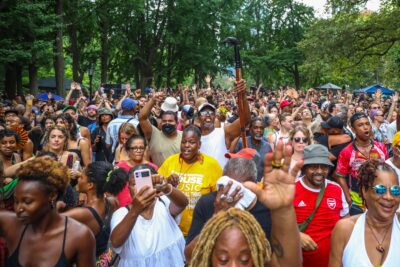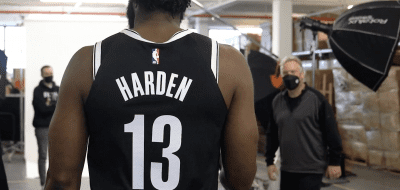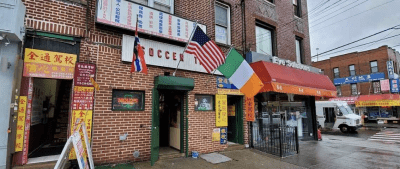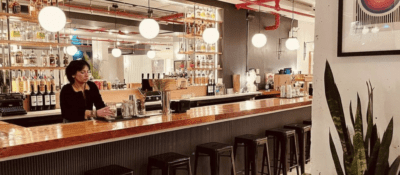Photo illustration by Johansen Peralta
A new book captures the essence of New York in the briefest moments
NYT editor Dan Satzstein discusses 'That's So New York,' his collection of the shortest, most-NYC stories
Like what you’re hearing? Subscribe to us at iTunes, check us out on Spotify and hear us on Google, Amazon, Stitcher and TuneIn. This is our RSS feed. Tell a friend!
What makes a story a New York story? Maybe it’s seeing a drag queen emerge from a manhole cover on Canal Street in a full look at 6:30 a.m. Or it could be a woman carrying a bag with a rambunctious live eel in it onto the subway to the shock of absolutely no one. The thing is, you know a New York story when you’ve got one.
“It’s very tempting to sort of use that old Justice Potter quote about pornography: you know when you see it,” says Dan Saltzstein, a New York Times editor who has collected a whole book’s worth of little vignettes, short stories and curated tweets that perfectly distill that New York moment to a second or two. “There’s a certain aspect that applies to these York moments. I think a couple of threads run through both the tweets and the essays in the book. One of them is almost like alternate universe quality.”
“That’s So New York: Short (and Very Short) Stories about the Greatest City on Earth” is out now and, in its own way, its very existence is a New York story: Saltzstein recalled one of his own very New York stories (involving Kim’s Video, naturally). He posted it to Twitter before it was X and asked his followers for their own New York stories. The tweet went viral, generating hundreds upon hundreds of hilarious bite-sized anecdotes that could only have happened here.
“I haven’t had a lot of viral tweets, but this was up there, it was thousands and thousands of responses, clearly had gotten way outside of my network, including hundreds of good ones,” says Saltzstein, who is this week’s guest on “Brooklyn Magazine: The Podcast.”
The book is in part a collection of some of those tweets and also longer — but no more than a page or two — stories from New York writers and notables. Here, we discuss what makes a story a New York story, and we get a little into his 25-year tenure at the Times, a span of time that has seen unimaginable earth-shattering tectonic changes to the media landscape and to the paper itself.
The following is a transcript of our conversation, which airs as an episode of “Brooklyn Magazine: The Podcast,” edited for clarity. Listen in the player above or wherever you get your podcasts.
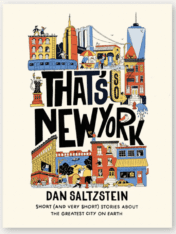 The book is very fun and very sweet. I’m sure you’ve told the story a bunch and you’re going to be telling the story a bunch, but how did it all come about? It started with a tweet. Take it from there.
The book is very fun and very sweet. I’m sure you’ve told the story a bunch and you’re going to be telling the story a bunch, but how did it all come about? It started with a tweet. Take it from there.
It did. About two years ago I tweeted with no intention of any kind. What happened was a story popped into my head and I thought, you know what? Instead of making this just a story, let me make it an open question, and the open question was: “New Yorkers, what’s your most New York moment?” Something to that effect. Tweeted it, put down my phone, woke up the next morning. I haven’t had a lot of viral tweets, but this was up there, it was thousands and thousands of responses, clearly had gotten way outside of my network, including hundreds of good ones. Questlove had responded.
Oh, did he really? That’s funny.
Clearly it made the rounds and had a blast sort of going through the stories and moments that people had responded with. And a whole bunch of people said, “You’ve got to put this into a book.” Well, I can’t just take people’s tweets and make a book out of it. So I thought, well, what can I do to surround those tweets with additional New York loving content? So yeah, I put together a proposal that included the best of the tweets, some essays by me and other writers, some interviews with people, New Yorkers who sort of interact with the city in interesting ways and silly little fact sheets.
The fact sheets are funny. What was the most New York thing that’s happened to you? There’s got to be a lot of them, you’ve been at the Times for 25 years.
I tweeted one and then I was like, just one more. And I tweeted one more and then it’s like I just got to stop myself because this could go on forever. But the original one was, this will date me a little bit, but if anybody remembers Kim’s Video on St. Mark’s Place, RIP.
The legendary Kim’s Video.
Legendary. I was hanging out in the East Village, actually lived around the corner from there at the time, and it must’ve been late nineties I guess, and I just really had to go to the bathroom. And so I went into Kim’s and I asked if I could use their bathroom, which I knew was for employees only. The guy behind the counter who was tatted up and pierced in every possible place just looked at me, was sort of uncaring look on his face and said, “Are you going to shoot up?” And I just thought that was just a great little moment that has stuck with me all those years. And this book is, in a weird way, placed in a certain time of Twitter, pre-X, pre-Musk, and there was a character count at the time, so the stories aren’t even really stories, they’re just moments.
Yeah, they’re vignettes.
So they’re like a lot of times unexplained, there’s very little context. I sort of love that. My original one was an example of that.
Even flipping through the book, I recognize some of the Twitter handles in there. In fact, one of my friends is in there. She’s the one who was at Veselka when the couple got thrown out for screwing in the bathroom at 4:00 a.m. and the woman was like, “Excuse me, we weren’t having sex. We were making love.”
I love that one. That’s great. Veselka pops up a couple times actually. One of the things that I did was sort of add these little annotations to certain of the tweets for non-New Yorkers. Hopefully will be lots of readers that will never have heard of Veselka. A little one sentence explanation of what Veselka is.
Even just the tweet going viral in the way it did is almost a New York story in of itself. Even though it’s on this ethereal social media platform, there’s something very New York about the fact that everyone was like, “Oh, I got one.”
It speaks a lot to the kind of city New York is. It also speaks, I think, to the fact that could you do this for any other city in America, maybe the world? And I’m not sure you could. I think you’re right, there’s something about New York that is sort of full of these little interactions that sort of come and go really quickly and some of them are funny, some of them are sad, some of them are poignant. You could probably do like an L.A. one, but I think it’d be very showbiz focused.
It’s an industry town. I grew up there and couldn’t imagine an LA one. But I could imagine one for each individual borough even, like what’s the most Staten Island thing that’s happened to you? What’s the most Bronx thing?
I live in Queens and I could definitely see that. And obviously Queens and Brooklyn are very much cities unto themselves.
So what makes a New York story a New York story? You sort of got to it a little bit, but what is the key characteristic that pops up a lot in these?
I say in the intro to the book it’s very tempting to sort of use that old Justice Potter quote about pornography: you know when you see it. There’s a certain aspect that applies to these York moments. I think a couple of threads run through both the tweets and the essays in the book. One of them is, I talked about this in the intro, almost like alternate universe quality. You’re living your life, but because you’re in New York, everything’s a little different than it would be elsewhere. I think that’s one aspect of it.
Another is the fact that New Yorkers have a certain sort of jaded quality, which doesn’t mean they’re unfriendly. There’s actually a chapter in the book called “New Yorkers Are Actually Nice.” And look, any big city people are in a rush. They’re on their way somewhere. There going to be sort of this veneer of gruffness, but once you get down to it, I actually think people in New York are really nice. Most New Yorkers have had this experience where something bad happens, somebody collapses on the subway platform or whatever and 10 people rush over to help and somebody’s calling 9-1-1, somebody’s putting something under the person’s head, whatever it is.
And one of those helping people might be Mandy Patinkin, who’s apparently helped so many people.
Chely Wright, who’s a singer and an activist, she had a series of tweet responses. The short version is I think it was a bicyclist get hit by a car. She goes over to help out, was kneeling down in front of the person and looks up and the other person who’s helping out as Mandy Patinkin. The full circle of that story is his son asked him on his Instagram account about that experience and whether he remembered it and his answer was, “No, I help a lot of people.” A great answer. But I would say New Yorkers are friendly, but there is this sort of jaded quality. We hear this a lot from celebrities, that they can sort of walk around New York without getting bothered because New Yorkers are sort of over it. That’s a thread that runs through them as well.
When I got done reading it, I was like, well, maybe New York is a simulation after all.
Exactly. There is a quality where it’s like somebody designed this, we’ll never know who.
We’re all in the Matrix. So it goes viral on Twitter. You collect all these amazing tweets. I would love to see the outtakes. I’m sure there are a lot of them. Then what, you reach out to writers? Some of them are in this book you have Josh Gondelman who’s been on this podcast. You have Molly Jong-Fast, who I’ve been a fan of for a long time. Andrew McCarthy, the actor, who probably has my favorite little story about seeing the same woman decades apart on the street. Getting people to reply to your tweet is one thing, but how do you collect the stories from some of these very established writers and public people?
It’s a combination of a couple things. One is, as you mentioned, I’ve worked at The New York Times for 25 years, and so I’ve been really lucky to edit a lot of really good writers. Some of these essayists fit in that category. Andrew McCarthy actually is now a travel writer.
Oh, is he? I don’t know what his raw copy was like, but his writing was lovely. It was very well put together.
He’s a good writer and he wrote for me when I was in the travel section at the Times for nine years, and he’s in there. I’ve edited him, Alexander Chee, Isaac Fitzgerald, Jason Diamond, Megan Abbott. Well, I tried to pick sort of a mix. And then there were other people who were just Hail Marys, Mahogany Browne. She’s a poet.
She’s the poet in residence at Lincoln Center?
Yeah. And basically what I did was the tweets, funnily enough fell naturally into seven categories and those categories became chapters. And so I sort of had those in my head and I basically sent them around to all the writers and I said, “Pick a category,” and as people picked categories, the category would fill up and then the list would get shorter. Mahogany, for example, is the opening essay. That chapter is called “New York is Magic,” which is sort of like what we were talking before, that sort of odd, surreal, extra real quality of New York. I also wanted to make sure that there were some native New Yorkers and some New York transplants, which there are. We were talking about Chicago before. Jason’s a good example, he’s from Chicago.
You were mentioning, yeah, the chapters are divvied up thematically — subways, the unspoken rules, the criminal, the celebrities. One of my favorite things that you did here was you do little interviews with “run-of-the-mill” New Yorkers who happen to have very interesting jobs, a subway operator, a doorman, an exterminator, all jobs that are in some ways uniquely specific to the city, or attributes of it are.
As I was sort of going through the chapters when it would pop into my head, the animals chapter is really, let’s be honest, rats and pigeons. I found this woman who I think she’s a second-generation owner of a pest control company and she is right out of central casting. I mean heavy New York accent, very opinionated about pests, mainly rats, as you can imagine. And what was funny about that interview was as we were talking, I was thinking, I think she loves rats.
Yeah, there’s little editorial interjections.
Yeah. If not loves, then it has a begrudging respect. That was sort of what I came away with. Her thing is basically rats are really smart. They’ve learned to survive in all parts of the world and all sorts of situations. Humans and rats can’t live together. One of the questions I asked her was, well, so what do we do? How do we get rid of them? You can’t, I mean unless you shut down all of the restaurants and collect twice a day, you’re basically not going to get rid of them and there’s not much you can do. So she was fantastic.
I like the subway operator one a lot, learned what it takes to become a subway operator.
I called her a conductor and she’s slightly offended, was sort of like, “I’m an operator, not a conductor.”and turns out a conductor, I didn’t know, this is the person in the middle of the train who controls the doors, and the operator is the person who actually drives the train
Another theme that comes up is the indifference of the city and the constant changing nature of the city. You have the writer, Isaac Fitzgerald, who you mentioned, in here and a piece that I liked a lot that concludes New York doesn’t care about you, which is sort of liberating. It just is. It doesn’t have an opinion about you positive or negative. Because people say all the time like, “Man, the city’s kicking my today,” but the city’s just existing.
It is existing. Yeah, totally. This is true of all cities I guess on a certain level, but people understandably complain a lot about gentrification and turnover in New York, and for plenty of good reasons. But I also feel like that’s New York City. I mean it’s constantly changing and evolving. There are positive consequences and negative consequences to that. There are people who get displaced, but there also are people who get opportunities that wouldn’t have existed before. There are areas where crime goes down. It’s largely a function of the city just doing its thing. Then there are things that people in positions of authority can do to sway things one way or the other on a certain level, but on a certain level really this is just the city chugging along.
One of the things I like to say is that we were talking about L.A. before, places like L.A. or D.C., those are industry towns. New York is an industry town, but it’s an everything industry town, basically everything is here. So that gives it a very different sort of vibe, I think, than a lot of other places. Some people hate it, some people find it too fast or too confusing or overwhelming or whatever.
One thing I’ve noticed is I went to college in the rural area and it would always take me a week or so to acclimate on both ends. When I went from New York to rural area in Massachusetts, it’d be like a week before I felt myself mellowing to the level of the area. And then vice versa, I’d come back to New York and I’d be all frenzied for a week and then I’d settle in and I’d be like, I guess I’ve adjusted.
You talk about your dad. He grew up in Crown Heights, which is a very different Crown Heights from what it is today. From conversations with him or memories that he shared with you, how would you characterize the Crown Heights of his childhood versus today?
So my dad’s about to turn 94.
Oh my gosh.
Yeah, so we were talking about ‘30s and ’40s. And at the time Crown Heights was largely a secular Jewish neighborhood. First, second generation immigrants for the most part. He’s a second generation. My mom’s first generation, she grew up in Inwood. I’ve asked him a lot, “Do you remember going to this neighborhood or that neighborhood?” And his main thing was the city was sort of the neighborhood for him. I mean sure, he went into Manhattan occasionally, Coney Island, places like that, but for the most part, well into his teen years, his New York was Crown Heights.
Part of that was the city was obviously very, very different at the time and he wasn’t allowed to go to Park Slope because of Italian gangs. He wasn’t allowed to go to Red Hook because of Irish gangs. So as a young teenage Jewish kid, places he wasn’t welcome. Both he and my mom have said, and I’ve heard this from other people too, I mean this is still true to a degree I guess, but in some ways an apartment building was like a little town. Everybody knows each other. There’s people interacting. People would come over from my dad’s side, Poland, on my mom’s side, Hungary, and you’d have half of a building from a handful of towns in one of those countries who went where their people were. That part I don’t think exists, at least in any large scale.
What does he think of you being an editor at the New York Times?
My parents specifically said to me, I guess it must have been in high school, “Don’t be a writer.” They wanted me to be a lawyer, go into political science, something like that. My dad’s a college professor, my mom is a psychologist, so to them being a professional means something very specific. The exception to that was as soon as I landed at the Times, it was like, oh, never mind. You’re good.
Speaking of the Times you’ve been there for a quarter a century now. What an amazing arc to be at the front row of the changing city landscape, the changing media landscape, the rise of digital, the demise of local news, to the transformation of the Times itself. When you think about those changes, what comes to mind?
When I think about my early days, I had an unusual arc at the Times. I took sort of a back door into it. I started in the late ’90s at a very short-lived website, The Time Zone called New York Today, which was sort of a time Out-style city guide, as a copywriter and editor. And in some ways it was ahead of its time. It would’ve made a lot more sense on mobile devices, which didn’t exist at the time as far as I can remember. I think I had a Treo. I don’t know if you remember Treos?
I remember Treo.
But there was almost no communication between us and the main newsroom. That site lasted for less than a year. I got lucky, they sort of pulled a few of those producers into the main website. But even then, I mean it really wasn’t until the mid to late aughts I would say when the Times went from not giving a crap about the web to freaking out about how behind we were and how we needed to catch up. And we did successfully. But nowadays, everything is digital first. I mean, I personally love print.
Me too.
I very much miss the days of helping art directors and photo editors lay out pages and design a section, and I do a little bit of it here and there, but not much. There’s so much energy here devoted to the web and off platform, as we like to say, social media and events and games now obviously is a big thing.
I’m hooked on their games.
They’re great. I have nothing to do with them, but they’re fantastic. It’s almost impossible to reconcile that with the way things were. Really it was 9/11. New Yorkers obviously will remember, it happened early in the morning. And back then what was on the homepage of NYTimes.com in the morning was that day’s paper. Now of course if you go to the paper of September 11th, 2001, it’s not about 9/11, it’s like the paper they closed at 1:00 a.m. the night before. We basically had to shut down the website for at least a day, maybe more, because the traffic overwhelmed the servers.
And that was the first inkling, “I think, this is something that’s going to stick around that we really have to pay attention to.” But even then it took a number of years, maybe mid- to late-aughts before they started actually putting resources to it and taking it really seriously. Just one example at the time, probably even into the early aughts, we have one videographer. We have a video team now of 40, 50, 60 people.
One of the big things is that we always say we would never make news decisions based on audience traffic, but we have the ability to assess traffic. You can’t assess traffic with a print product, you know how many people subscribe to the paper, but anything more granular than that is impossible.
You don’t know which stories are resonating, you don’t know which sections are the most popular or things like that.
That’s been a big change. And the tempo, I mean the 24-hour news cycle, we were not on a 24-hour news cycle when I started and we very much are now. And we have now had this very elaborate process where the nerve center of the newsroom moves from New York to London to Seoul back to New York. It allows where the news report is driven to shift to daytime hours wherever it is.
That’s fascinating. Totally makes sense. You said you had a weird entry to the Times. What’s your beat today? You’re an editor, you’re not out there writing, reporting. You were a travel editor for nine years. What are you on these days?
I’ve moved from travel to a group called Special Projects, which is now technically called Projects and Collaborations, which I don’t think is any more clear than Special Projects. But the way I describe it is we sort of do projects that either fall in between desks that might not otherwise happen or fall across desks and both coordinate but also do our own journalism. So just as example, we’re about to launch a big project about the 100th anniversary of the Harlem Renaissance. There’s no single date, but people generally date it to 1924. And we’re hoping for it to be a look back in a lot of ways, but also a look at the continuing legacy of the Harlem Renaissance, the contributions from the real estate desk and we’re talking to culture and food and other desks about it, but that’s a good example of a project that no one desk would own. We do a lot of that sort of thing.
And then we do a lot of also experimentation, different story forms using new tools that we’ve developed, incorporating video and reader interaction and all sorts of stuff like that. It’s a fun team to be on. I’ve never been a beat reporter. I’ve never been a hard news editor. I’ve always worked in features. And I’ve written plenty for the Times, but I’ve never had a beat. When I did work in travel, this is back when things were largely print driven and I would work on two, maybe three stories a week that would be in next week’s travel section. In some ways it was great. I loved it, got to work with great writers and worked with art director and photo editor on presentation layouts in print and online. The travel section every year has this big 52 Places project. I led that for five years. It’s a massive machine. It’s just like this enormous puzzle.
That’s not the project where you had one writer travel the world for a year?
So that was an offshoot. The list is 52 Places to Go, and that’s existed, I’m not sure for how long, 15 years, something like that. And then for two years we had a 52 Places traveler. The first one was Jada Yuan, who’s now at the Washington Post, and the second was Sebastian Modak, he’s at The Wall Street Journal now. He’s great. The first year with Jada, god bless her, she’s a great writer. We didn’t know what we were getting into with that. As you can imagine, the logistics of sending somebody to a different place every week is just insane. I’m glad we did it, but there’s a reason why we only did it twice.
It sounded like it could have been a dream or nightmare job, or a little bit of both.
I think if you asked them they would say it’s both. It’s incredibly exhausting, but also I’m sure electric and an amazing way to spend a year.
We’ve got off-topic from your book, but we can bring it back around. There’s a lovely piece in here where you interview a doorman. He has a line in there where he says, “Certain things about New York just are, there’s no point to fight it.” I guess you went into it looking for some juicy gossip about the building, but got a very lovely family feel.
He’s a doorman at a fancy building on Fifth Avenue. I was expecting a lot of juicy gossip and he really talked about how he feels like he’s part of this big family and how he feels responsible for people in the building. Things like blackouts and blizzards and stuff like that where there’s older people in the building who he really watches out for. And he’s seen kids grow up. And it makes sense when you think about it, but it’s not what I expected.
It’s not as sexy.
Right, it’s not as sexy. My wife and I live right on the border of Woodside and Sunnyside in Queens, and there’s four high rises right in a row in what is otherwise a pretty flat area. We’re in a co-op and there’s 220 units in each building. It’s pretty big. We’ve been in this building for 20 years. We started on the top floor and actually have a large tattoo on the inside of my forearm. It’s a sunset. We lived on the 12th floor facing west, so we got these amazing sunsets of the skyline. One interesting and sad fact is that that view basically no longer exists. We’ve moved from the 12th floor to the eighth floor for a larger place when we had a kid. The guy who bought that apartment from us saw me in the elevator one day and he said, “I’ve got to take a picture of that because my girlfriend’s never going to believe it.” And I said, “Wait, what do you mean?” He said, “All those 40, 50 high rises that have gone up in Long Island City have completely obscured that view.” I’m sure it’s still lovely, but it’s not the same view that I had.
That goes to one of the main through lines is that New York is ever-changing and it doesn’t care about your view.
It really doesn’t, and I’m sure a lot of New Yorkers have had this experience, going to neighborhoods where you haven’t been in a long time. There was a period where I hadn’t been to the Lower East Side in a while and I went and I was like, “What the hell is going on? What are all of these boutiques and restaurants?” Now, I go to a lot of those restaurants, they’re great, but the vibe is just completely different. I mean, go down the list of neighborhoods that have transformed in one way or another.
I found a piece of yours in the Times, just a couple of years old, where you went into the Times Machine — anyone can search the Times Archives going back to the 1800s — and you searched your family name, because it’s a unique family name, Saltzstein. And you found a Saltzstein that may be related to you?
There’s sort of an update to that, which is interesting. So one of the first things I did when I got to the Times was search the archives for my last name for the exact reasons you described, and I found a few references. My great uncle on my dad’s side was Carlo Gambino’s book maker.
Oh wow.
That I knew about, but I didn’t know the specifics of it. And one little side note, when I did write that article, I mentioned that his name was Harry Saltzstein, his partner was George Schiller. I got an email one day from Amy Schiller and she’s like, “That’s my grandfather.” And I had an hour-long Zoom call with five Schillers and she and I have become friends. The article is hilarious, it says something like they both get arrested. My great uncle is described as a convicted burglar and bookmaker I think. And his partner George Schiller, about whom little is known, which I just love.
So I also found a reference to a Mike Saltzstein who ran the Coney Island carousel for 25 years. I’d never heard that name, passed it by my dad. He had never heard that name. He was born and grew up two miles from my dad, whatever the distance from Coney Island to Crown Heights. But around the same age. I talked to a whole bunch of people who knew him, he didn’t have any surviving relatives. I talked to the guy who wrote the obit. He didn’t know more information. So I sort of sat on that for many, many years. Finally, just popped back into my head and I’m like, you know what? I’m going to go down to our photo archives, which we call the morgue, which is an amazing place. It’s insane. There’s literally millions and millions of photos and many more millions of negatives. I said to the guy who runs the place, Jeff, “Give me all the Coney Island stuff.” And, you know in a movie, when somebody asks for something and they drop a massive thing in front of them?
Dossier.
Exactly, and dust flies. It was like that. And I start going through it and about halfway through a contact sheet of photos of a guy who was clearly Mike Saltzstein, guy in a work suit on the carousel and all the photos in the archives have what’s called a verso, which is just the other side of the photo that has when it was published, the caption that went with it, that sort of stuff.
The metadata.
The old school metadata. These photos have never been published. They were supposed to run with an Anna Quindlen column back when she was a Metro columnist. I contacted Anna Quindlen. She’s like, “I don’t remember that. I don’t ever remember us killing a column, so I don’t know why it would not have run.” But it never did. So we had them enlarged and I wrote that story, still without knowing if or how we were related. This is another Twitter connection, so I post the story on Twitter. Literally within 15 minutes, a specialist in Jewish genealogy says, “I am 95 percent sure that Mike Saltzstein and your dad or third cousins,” which makes me third cousin once removed.
The cousin math is very confusing.
Very confusing. Basically a second, third, fourth cousin that has to do with how far back on the family tree you split off and this gives you a sense of generational time. Third cousin, you’re already in 19th century Poland when we were the Zaltzsteins, and so I can’t remember the relative where it branches off from, but that’s how far back you have to go to connect me with Mike Saltzstein.
I found a reference to my — I don’t know how many greats are in there — great-great-grandfather, great-great-great-grandfather? — from a copy of The Times in 1905. The opening sentence is “A gang in East New York attacked Max Braiker, a contractor and boss bricklayer and some of his workmen last evening.” And it goes on from there.
Incredible.
The Times Machine is a great toy. Anything you want to say about the book before I let you go back to your day?
Available wherever you get your books. One of the thing swe haven’t mentioned is, which I’m not responsible for, is that there’s an amazing illustrator who did illustrations for the book, Emily Carpenter, who is just a genius as far as I’m concerned and went to town on some of the stories and tweets in the book and really brought them to life. So I’m indebted to her.
Check out this episode of “Brooklyn Magazine: The Podcast” for more. Subscribe and listen wherever you get your podcasts.
You might also like 

















